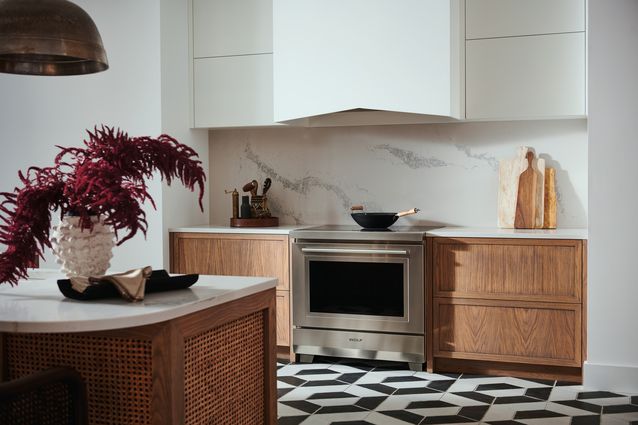Brigitte Shim co-founded her Toronto-based practice Shim-Sutcliffe in 1994 with partner A. Howard Sutcliffe. Despite their small scale, their contribution to global architecture has been great, with projects peppered across Canada, Russia, Hong Kong, and Hawaii.
To date, Shim-Sutcliffe has received an unprecedented 15 Governor General’s Medals for excellence, and in 2021, the practice received the RAIC Gold Medal in 2021 – the country’s highest distinction for architecture, awarded to practices making a “significant and lasting contribution to Canadian architecture”.
The pair share a passion for the integrated and interrelated scales of design, their work covering a broad swathe of projects, from furniture, lighting to landscapes, as well as architectural projects of all sizes and typologies, from garden pavilions to religious institutions.
Ravine Guest House
Image:
Raimund Koch
“I was born in Kingston, Jamaica, and Howard was born in Yorkshire, England. I would say that makes us truly Canadian, because we both come from somewhere else,” Brigitte Shim said. She recalls her arrival in Canada in 1965 as a seven-year-old during a blizzard, and the impact this early experience had on her enduring regard for the landscape.
“Coming from such a different climactic zone, experiencing snow and the vastness of the Canadian landscape for the first time leaves a big mark on you,” she continued. “My family took in the landscape travelling across Canada from the west to the east coast, camping all the way in a Volkswagen van. I feel like we really came to appreciate and respect the beauty and vastness. I would say Howard’s family did the same.”
Shim attributes this early reverence for the Canadian landscape with a lifelong interest in nature, translating in a sensitivity and responsiveness to the natural environment that has come to define their work as a practice. Working in Canada, the second largest country in the world by landmass, has had a humbling impact on their work.
“No matter how big you think your building is, it’s puny in relation to the landscape,” Shim said. “You have to use the landscape, work with it, to think about how the footprint of your building can both resonate with the landscape and have an impact on it.”
In this sense, Shim says their work is more about placemaking than object making. “The two have to work in a complimentary and synchronistic way to really make a place that isn’t just about objects sitting on a site.”
Garden Pavilion and Reflective Pool, 1988
Image:
Raimond Koch and Scott Norsworthy.
The pair’s first project was a garden pavilion constructed in 1988, before they had officially established Shim-Sutcliffe – a Corten steel canopy and reflective pool without walls or doors, where the only mechanical system onsite was a pump for a running fountain. This first venture cemented for the duo ideas that would hold strong throughout their careers.
“If you think back to this idea of placemaking over object making, I feel like that first experience of trying to navigate trees using beam grades, or thinking through issues of grading and typography, were really important [to our eventual process].”
Shim-Sutcliffe’s architecture plays the long game, engaging in what Shim refers to the “tussle” between built form and organic forces. It’s architecture that is designed to weather, rust and patina; that incorporates the seasonal transformations of water, from ice to liquid to mist. “We actually think of time as a material in our work,” she said.
Integral House
Image:
Ed Burtynsky
Shim says the pair are not concerned with certain issues of currency, and they rarely look at magazines or pay attention to trends. The garden pavilion, for example, was photographed 30 years after its completion. Marked by time and enveloped in a matured landscape, Shim said it more closely resembled the vision they had for it than when it was originally constructed. “In a way, these are more unpredictable elements, but they add a whole dimension to your reading of architecture,” said Shim.
Their work’s incorporation of the ineffable qualities of nature and light has helped them to carve out a metier in the design of spiritual and sacred spaces. Shim-Sutcliffe has been responsible for the design a catholic temple for Residence for the Sisters of St. Joseph of Toronto; a synagogue for the Jewish Reform Congregation Bet Ha’am in South Portland; a Daoist temple for a community in Toronto; and a project on a sacred site to the First Nations Chippewas of Rama.
Their large portfolio of projects in this classification has come about almost incidentally, but is perhaps not surprising, given the poeticism of their buildings has been renowned for a quality that is almost transcendental.
“It’s been an interesting body of work to explore because all have been so different in terms of liturgies. A Daoist temple isn’t the same as a Catholic chapel, isn’t the same as a synagogue,” Shim explained. “But in terms of how they should look, there really isn’t a huge set of requirements. There is no typology for a synagogue – it can be anything. And a Daoist temple in the 21st century – there’s no playbook that says it must be this or that.
“What’s interesting is that so many of those projects are about light in architecture: the way light is let in, and the shaping of light, the manipulation of light, and how that actually impacts the space.”
Brigitte Shim and Howard Sutcliffe will be presenting at The Architecture Symposium: Ideas from the Fringe on Saturday 4 March 2023.
The Architecture Symposium is a Design Speaks program organized by Architecture Media, publisher of ArchitectureAU.com, and supported by Brickworks and the University of Tasmania. Click here to buy tickets.














